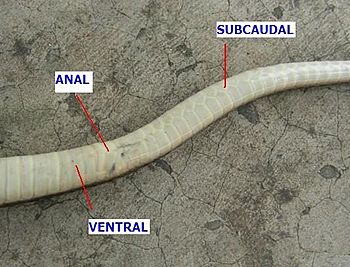Subcaudal scales facts for kids
Have you ever wondered about the different scales on a snake? Snakes have many types of scales that help them move and protect their bodies. One important type is the subcaudal scales. These are special, larger scales found on the underside of a snake's tail. They are located just after the anal scale, which is a single scale near the snake's vent (where waste leaves the body).
Contents
What Are Subcaudal Scales?
Subcaudal scales are like flat plates that cover the bottom part of a snake's tail. The word "subcaudal" means "under the tail." These scales are different from the smaller, overlapping scales found on the top and sides of a snake's body. They are usually wider and more noticeable.
Single or Divided: A Key Difference
One interesting fact about subcaudal scales is that they can be either single or divided.
- Single subcaudal scales mean each scale goes all the way across the underside of the tail in one piece.
- Divided subcaudal scales mean each scale is split into two smaller scales down the middle. This makes them look like they are in pairs.
The way these scales are arranged can be a clue to what kind of snake it is! Scientists often look at subcaudal scales to help identify different snake species.
How Do Subcaudal Scales Help Snakes?
These scales play a role in how a snake moves and protects itself.
- Movement: While the main body scales (called ventral scales) help snakes grip surfaces and push forward, subcaudal scales also contribute to movement, especially when a snake is climbing or moving its tail.
- Protection: Like all scales, subcaudal scales provide a tough outer layer that protects the snake's tail from injuries and helps keep its body hydrated.
Scales Near the Tail
The subcaudal scales are part of a group of important scales found on a snake's underside.
- Anal scale: This is a single scale located right before the tail begins. It covers the snake's vent. The anal scale can also be single or divided, just like subcaudal scales.
- Ventral scales: These are the large, wide scales that run along the entire belly of the snake, from its chin all the way to the anal scale. Ventral scales are crucial for a snake's movement, helping it grip the ground and push itself forward.
Understanding these different types of scales helps us learn more about how snakes are built and how they live in their environments.


